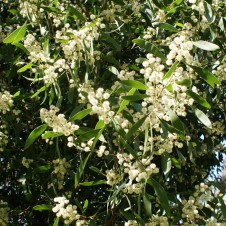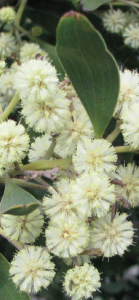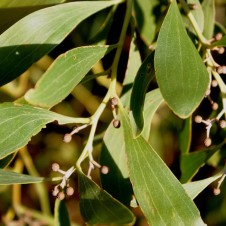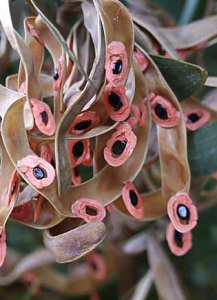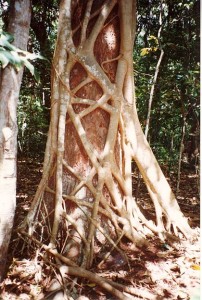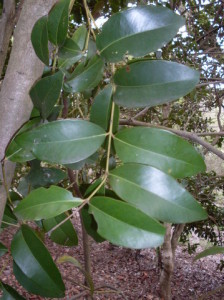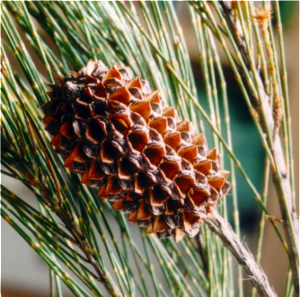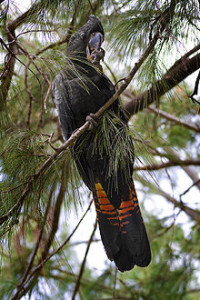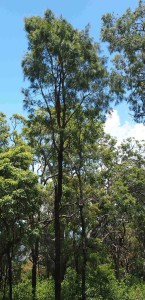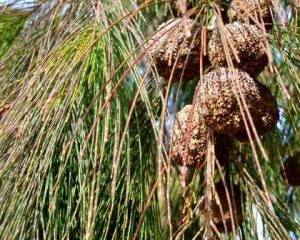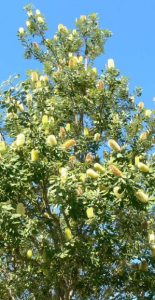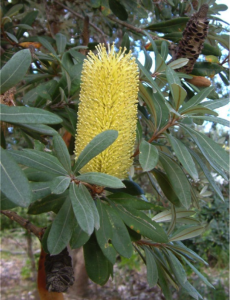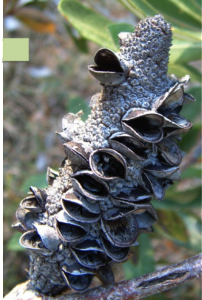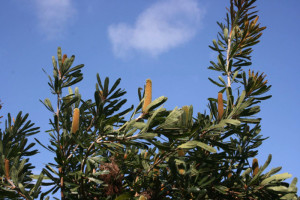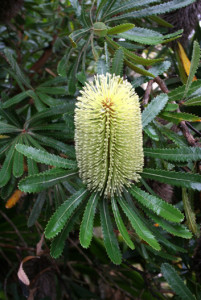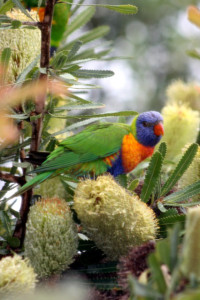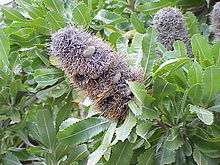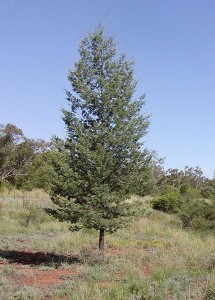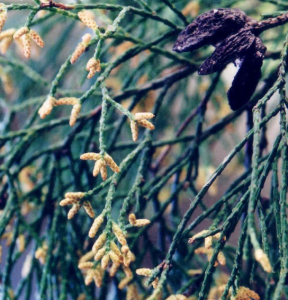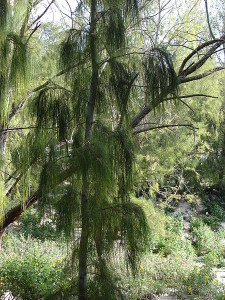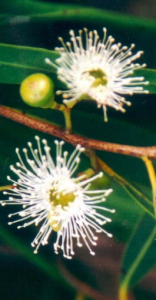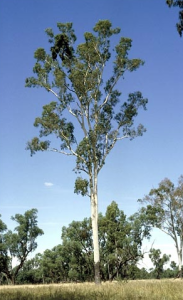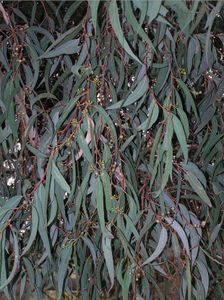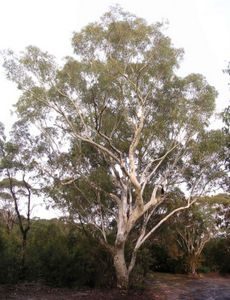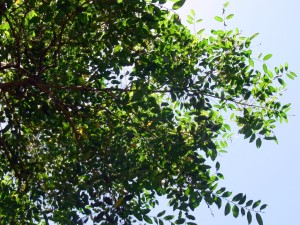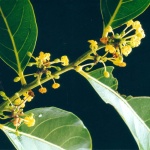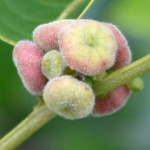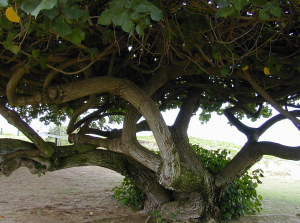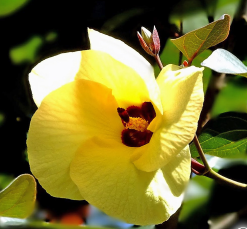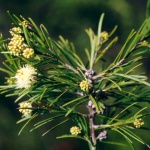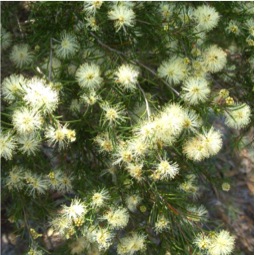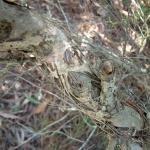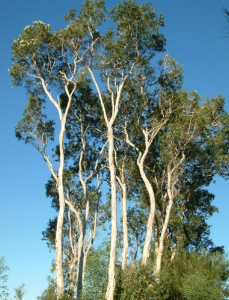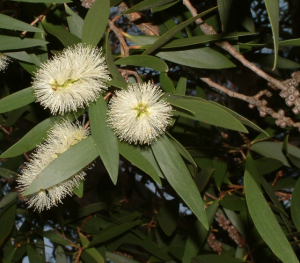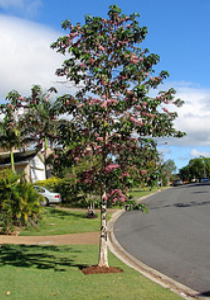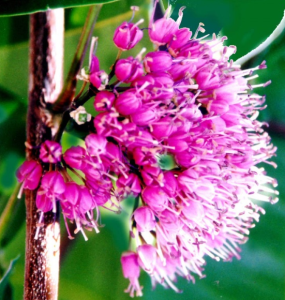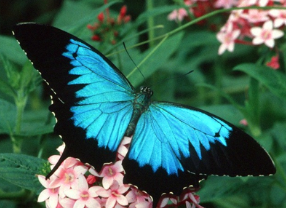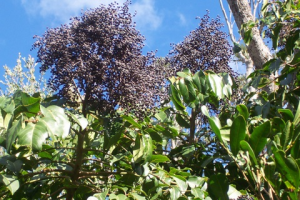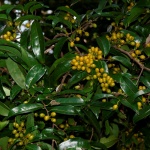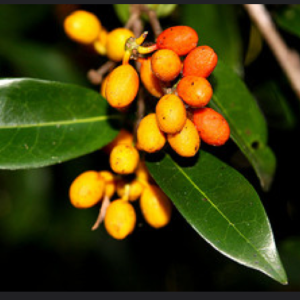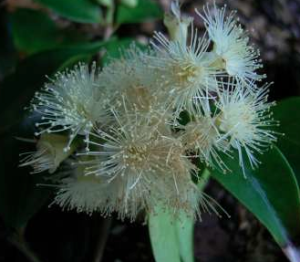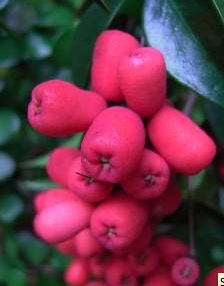Acacia melanoxylon (Blackwood)
Form: 6-12m in an open sunny situation and up to 25m in rainforest
Aspect: Full sun/ Semi-shade
Soil/Conditions: Adaptable, prefers well drained soil, frost resistent
Habitat: Lowland subtropical rainforest
Description:
It is fast growing, with a soft white corky trunk
Masses of delicate pink flowers on the trunk in summer.
Unusual coiled / twisted seed pods
Family: Mimosaceae
Special Features:
Good for Erosion Control and Revegetation
Frost Tolerant
Long invasive root run
Valuable Timber Tree
Host tree for indigenous Butterfly Larvae
Native pigeons enjoy the seeds
Aborigines used bark and twigs for fish poison as a means of fishing
Acmena hemilampra (broad-leaved lilly pilly)
Form: Tree 8-20m tall.
Aspect: Full Sun
Soil/Conditions: Moist, well drained, tolerates salt spray
Description:
Glossy dark green leaves with red new growth,
greyish flaky trunk,
fluffy white flowers in spring and summer,
white succulent edible fruit.
Family: Myrtaceae
Natural Habitat: Rain Forest
Special Features:
Excellent feature tree or shade tree.
Planted in Birtwill St, Coolum as street tree.
Aliphitonia excelsa (Red Ash, Soap Tree)
Form: Tree to 10-18 metres tall.
Aspect: Full sun/ Part shade
Conditions: Well-drained
Description:
Fast growing adaptable tree that prefers well drained soils.
Distinctively mottled trunk.
Clusters of small whitish flowers in Autumn followed by black fruits.
Leaves are white underneath.
Very hardy, grows near the sea and in hinterland areas.
Family: Rhamnaceae
Allocasuarina littoralis (Black Sheoak, Coastal Sheoak)
Form: Tree 6 – 10 metres tall
Aspect: Full sun/filtered sun
Soil/Conditions: Adaptable
Description:
Hardy & very fast growing, slightly pendulous branches with brown male flowers & bright red female flowers on separate trees.
Excellent screening tree in narrow situations (e.g. between houses and along fence lines).
Family: Casurinaceae
Special Features:
Allocasuarina tortulosa (Forest Oak)
Form: Tree 10 to 20 metres tall.
Aspect: Full sun/Filtered sun.
Soil/Conditions: Adaptable/Well-drained.
Description:
Medium to large tree in Eucalypt forests.
Corky bark and needle-like “leaves”.
Large woody seed come up to 4cm long.
A food source for the glossy black cockatoo.
Prefers soil with at least some good drainage.
Fast growing and hardy.
Family: Casuarinaceae
Special features:
Good windbreak plant.
Glossy black cockatoo feeding tree.
Male and female flowers on separate plants.
Fallen needles for plant-excluding mulch.
Aboriginal food and tool source.
Banksia integrifolia (Coastal Banksia)
Form: Tree 6 to 10 metres tall
Aspect: Full sun
Soil: Adaptable/ Moist
Description:
Medium tree of variable height, smaller on dunes and windy areas.
Iconic tree of the Sunshine Coast.
Greyish-green leaves & yellow flower brushes to 15cm.
Woody seed cones remain on tree and drop seeds.
Family: Proteaceae
Special Features:
Attracts birds including Yellow-Tailed Black Cockatoo.
Salt spray resistant.
Excellent for exposed coastal sites, and as a street tree/feature tree.
Banksia serrata (Red Honeysuckle)
Form: Tree to 10 metres tall.
Aspect: Full sun
Conditions: Adaptable
Description:
Small spreading tree with massive trunk in proportion to height.
Greyish-green leaves and yellow-greenish cream flowers.
Flower spikes to 20cm in late Winter.
Attracts birds.
Salt spray resistant.
Frost tolerant.
Family: Proteaceae
Special Features:
Bird attracting.
Bee attracting.
Screen tree.
Cockatoo and lorrikeet food tree.
Callitris columellaris(Coastal Cypress)
Form: Tree 10 to 30 metres tall.
Aspect: Full sun/filtered sun.
Soil/ Conditions: Well-drained/ Sandy
Features:
Coastal tree found on sandy soils on headlands and sand dune areas.
Straight trunk.
Fissured bark.
Small spherical woody fruit.
Dense needle-like foliage.
Very attractive long-lived medium to large tree.
Family: Cupressaceae
Special Features:
Excellent windbreak.
Termite and marine borer-resistant timber.
Aboriginal tool and medicinal source.
Resin used in medicine, paint and adhesives.
Casuarina equisetifolia Horse-tailed oak, Coastal Sheoak
Form: Tree 6 – 8 metres tall
Aspect: Full sun/filtered sun
Soil/Conditions: Adaptable
Description:
Graceful drooping habit, fine foliage “sings” in the breeze.
Reddish brown flowers in March-May followed by bird attracting seed pods.
Self mulching.
Tolerates S/E ocean winds.
Family: Casurinaceae
Special Features:
Casuarina glauca (Swamp Oak)
Form: Tree 10 to 20 metres tall.
Aspect: Full sun/ Filtered sun
Soil: Wet/ Adaptable
Description:
Rounded conical shape, slightly pendulous branches & needle-like foliage.
Male & female flowers on separate trees in July-Nov.
Hardy & good in salty, swampy areas.
Fast growing and self-mulching.
Family: Casuarinaceae
Special Features:
Corymbia tesselaris (Moreton Bay Ash)
Form: Tree to 30 metres tall
Aspect: Full sun
Conditions: Adaptable/ Well-drained
Description:
Open drooping habit.
Deciduous perennial.
Green, pendulous leaves to 18 cm.
White flowers to 15 mm in Summer.
Light brown woody capsules to 11 mm.
Family: MYRTACEAE
Special Features:
Attracts birds, especially Lorikeets.
Single white trunk with grey bark at base.
Branches widely at height.
Salt spray tolerant
Eucalyptus bancroftii
(Bancroft’s Red Gum or Tumbledown Gum)
Form: Small tree 6-8m in dry heath on sand. Often crooked or straggly.
Aspect: Full Sun / Semi-Shade
Soil/Conditions: Coastal lowlands
Description:
Leaves alternate, curved, leathery, 22cm x 4cm. Aromatic when crushed.
Flowers spring and summer. Buds 1.5-2cm long.
Bark smooth, grey, dull.
Family: Myrtaceae
Natural Habitat:
Mainly found on well-drained skeletal soils on rocky hills, but also occurs on lower slopes and generally with better form
Extremely drought, frost and wind tolerant
Special Features:
Valuable wildlife habitat, providing nectar and pollen for native birds and insects
Wood is fairly durable; used for fencing and firewood
Good quality honey tree
Eucalyptus racemosa (Scribbly Gum)
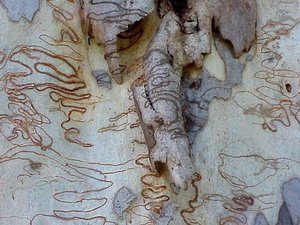
Form: Tree 15-20m on deep sandy soil.
Aspect: Full Sun / Semi-Shade
Soil/Conditions: Coastal lowlands
Description:
Leaves alternate, drooping blue-green, 19cm x 1.5cm. Not to be confused with Eucalyptus haemastoma, with broader and shorter leaves.
White flowers form between August and September.
Life expectancy > 100 years.
Family: Myrtaceae
Natural Habitat:
Usually on coastal lowlands, but sometimes inland and at higher altitudes.
Special Features:
Bark white, but marked with the “scribbles” of insect larvae
Attracts fauna when in flower for its nectar production. Foliage is browsed by Koalas, however not as readily as E. haemastoma. Very old trees can develop hollow logs which are utilised by a wide range of Australian fauna. Isolated plantings may fail to attract the characteristic Scribbly Gum Moth.
Glochidion sumatranum (Umbrella Cheese Tree)
Form: Tree 10-15 metres tall
Aspect: Full sun/filtered sun
Soil/Conditions: Moist
Description:
Graceful habit, umbrella shaped canopy, attractive glossy foliage with pink new growth.
Green-yellow perfumed flowers in Oct/Dec.
Pink rounded fruit shaped like a European cheese wheel.
Very fast growing.
Excellent pioneer tree for revegetation.
Attracts Lewin’s Honeyeater.
Family: Phyllanthaceae
Hibiscus tiliaceus (Cotton Tree)
Form: Tree to 9 metres tall
Aspect: Full sun
Conditions: Adaptable/ Well-drained
Description:
Spreading shade tree.
dense heart-shaped foliage with large bright yellow flowers to 14cm diameter in Spring.
Aboriginals used bark infusion as antiseptic & to make rope.
Salt spray tolerant, frost tender.
Adaptable, attractive ornamental tree, excellent in coastal sea-spray areas.
Very fast growing and long lived.
Tolerates brackish water.
Aspect: Full sun/filtered sun
Soil: Adaptable
Description:
Single grey trunk.
Shiny green, fan shaped leaves to 1.8m wide & 4m long.
Creamy white flowers & black fruit.
Tolerates full sun, salt air, and a variety of soils including sand.
Special features:
Attracts birds & butterflies.
Melaleuca nodosa (Prickly-leaf Paperbark)
Form: Spreading shrub or tree to 7 metres (usually less)
Aspect: Full sun
Soil/Conditions: Adaptable
Description:
Shrub with papery layered bark, drooping stems and pointed leaves.
Masses of creamy-yellow flowers in spring and summer.
Popular screen plant for areas exposed to salt spray.
Very hardy & frost tolerant.
Important pollen source for bees.
Family: Myrtaceae
Melaleuca quinquenervia (Coastal Paperbark)
Form: Tree up to 25 metres tall
Aspect: Full sun/ Filtered sun
Soil: Moist/ Sandy
Description:
Attractive tree with distinctive papery bark.
creamy white (sometimes red) flowers to 8cm long in Spring & Winter.
Family: Myrtaceae
Special Features:
Flowers attract birds, bats, bees & butterflies.
Aborigines used young leaves for headache & cold relief.
Excellent tree for wetter areas, shade tree.
Melicope elleryana (Pink Euodia, Corkwood)
Form: 6-12m in an open sunny situation and up to 25m in rainforest
Aspect: Full sun/ Filtered sun / Frost free
Conditions: Although adaptable, they do prefer well drained soil
Habitat: lowland subtropical rainforest
Description:
It is fast growing, with a soft white corky trunk
Masses of delicate pink flowers on the trunk in summer.
An ideal shade tree for a large garden or park.
A spreading canopy of up to 4m and spreading surface roots
Branches respond well to pruning
The tree thrives if watered and fed through dry periods
Family: RUTACEAE
Special Features:
Attracts a variety of nectar feeding birds, fig birds
Attracts butterflies such as the Orchard Swallowtail butterfly.
Milled as a general use timber
.
.
Pandanus tectorius (Pandanus)
Form: Tree to 6-9 metres tall.
Aspect: Full sun.
Soil/Conditions: Adaptable/Well-drained.
Description:
Iconic coastal tree.
Architectural features.
Interesting prop roots, many nranches, narrow serrated leaves to 1m long.
Tiny grey flowers and very large bush tucker fruit to 40cm wide.
Leaves used to make dillybages, etc and fruit can be eathen, although causes throat irritation.
Fruit eaten by crabs and bats.
Family: Pandanaceae
Polyscias elegans (Celery Wood)
Form: Tree to 15m, very fast growing.
Aspect: Full Sun / Semi-Shade
Soil/Conditions: Higher rainfall areas
Description:
Pioneer species quickly filling gaps caused by vegetation disturbance.
Saplings often unbranched. Wood white, very soft and light.
Slender fast growing, celery scented timber.
Generally regarded as a rather inferior species for the production of timber.
Family: Araliaceae
Natural Habitat:
A characteristic tree of disturbed rain forest in the higher rainfall areas but also grows as a canopy tree in monsoon forest and drier rain forest
Special Features:
The fruit is eaten by a large variety of birds, including brown cuckoo dove, Australasian figbird, green catbird, Lewin’s honeyeater, olive-backed oriole, pied currawong, paradise riflebird, rose crowned fruit dove, silvereye, superb fruit dove, topknot pigeon and wompoo fruit dove.
Polyalthia nitidissima (Canary Beech)
Form/Size: Tree to 18 metres
Aspect: Filtered sun.
Soil/ Conditions: Well-drained/ Adaptable.
Description:
Medium-sized tree, glossy green foliage to 13cm long.
5cm green flowers in Summer/Autumn and red oblong fruit.
Excellent tree for a larger garden that will grow well in a semi-sheltered spot.
Shade tolerant.
Family: Annonaceae
Description:
Medium-sized tree.
Glossy green foliage to 13 cm long.
5 cm green flowers in Summer/Autumn and red oblong fruit.
Excellent tree for a larger garden that will grow well in a semi-sheltered spot.
Shade tolerant.
Syzygium luehmannii (Small Leaved Lilly Pilly, Riberry)
Soil: Adaptable
Dense weeping habit, attractive glossy dark green foliage& bright pink & red young foliage.
Lovely white fluffy flowers in Spring/Summer.
Bright red edible fruit in Dec to Jan.
Family: Myrtaceae
Attracts birds.
Good street or screen tree.
Can be pruned to form hedges and screens.

